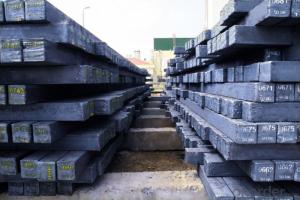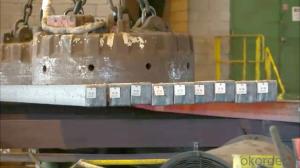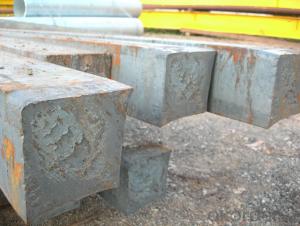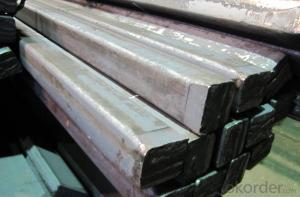Q235/3SP 155MM Blast Furnace Hot Rolled Steel Billet
- Loading Port:
- Tianjin
- Payment Terms:
- TT OR LC
- Min Order Qty:
- 2000 m.t.
- Supply Capability:
- 30000 m.t./month
OKorder Service Pledge
OKorder Financial Service
You Might Also Like
Description of Q235/3SP 155MM Blast Furnace Hot Rolled Steel Billet
Our hot dip galvanised steels consist of a steel substrate with a metallic zinc coating applied by means of a continuous hot dip galvanising process. Metallic zinc coatings are available in steel grades ranging from steel for bending and deep drawing applications, to structural steels and high yield strength steels.
A glossy surface finish obtained under specific skin-pass conditions (either non-skin-passed or skin- passed with smooth cylinders to obtain low roughness) can be provided if required at time of enquiry.
Advantage of Q235/3SP 155MM Blast Furnace Hot Rolled Steel Billet
Uncoated CR steel sheet With the features of in line with the international highest standards in demension and shape, excellent surface finish and properties, the products are mainly used in home appliance and automobile industries.
Galvanized steel sheet(include HDG and EG)
With the features of good corrosion resistance, the products are mainly used in automobile, home appliance, electronics, building and machinery manufacture industries, etc.
Precoated steel sheet With the features of enviromental protection and good processablility, long lasting surface durability, rich in colors, the products are maily used in building, home appliance and furniture industries, etc.
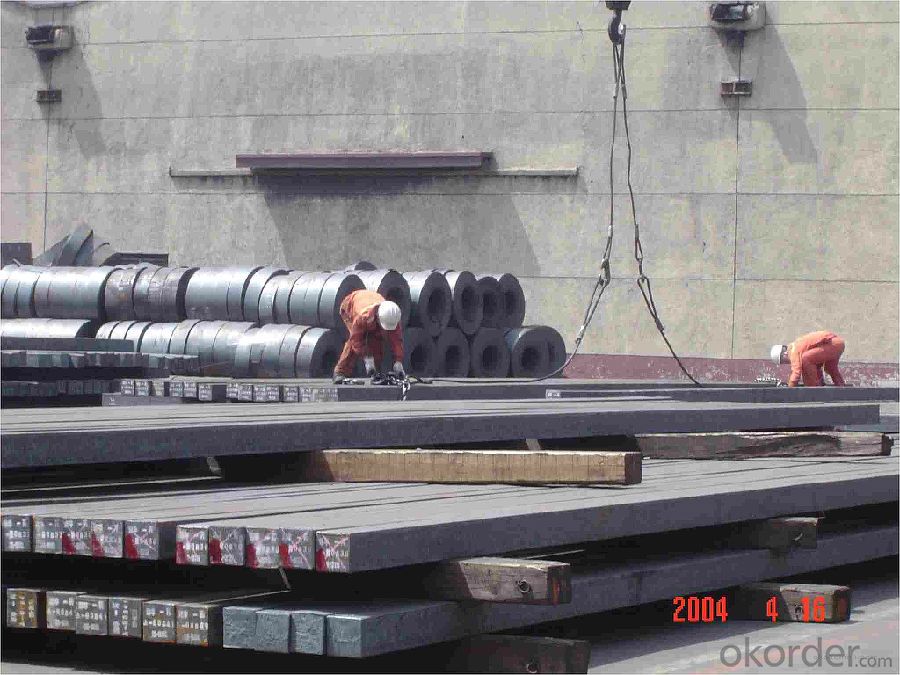
Applications of Q235/3SP 155MM Blast Furnace Hot Rolled Steel Billet
Our hot dip galvanised steels can be used in a very wide range of applications for industrial markets, both indoors and outdoors. Some of the most common applications are:
Building: wide sections for roofing and cladding, doors, door frames, metallic ceilings, partitions, structural members etc
Domestic appliances: all appliances for this sector (both white and brown goods) are manufactured with hot dip galvanised steels
Miscellaneous: electrical cabinets, aeraulic components, air conditioners, road signs etc
Zinc hot dip galvanised steel is suitable for contact with foodstuffs under certain conditions, as specified in European directive 89/109/EEC and French standard NF A 36-712-1. Please contact us for further information on this subject.
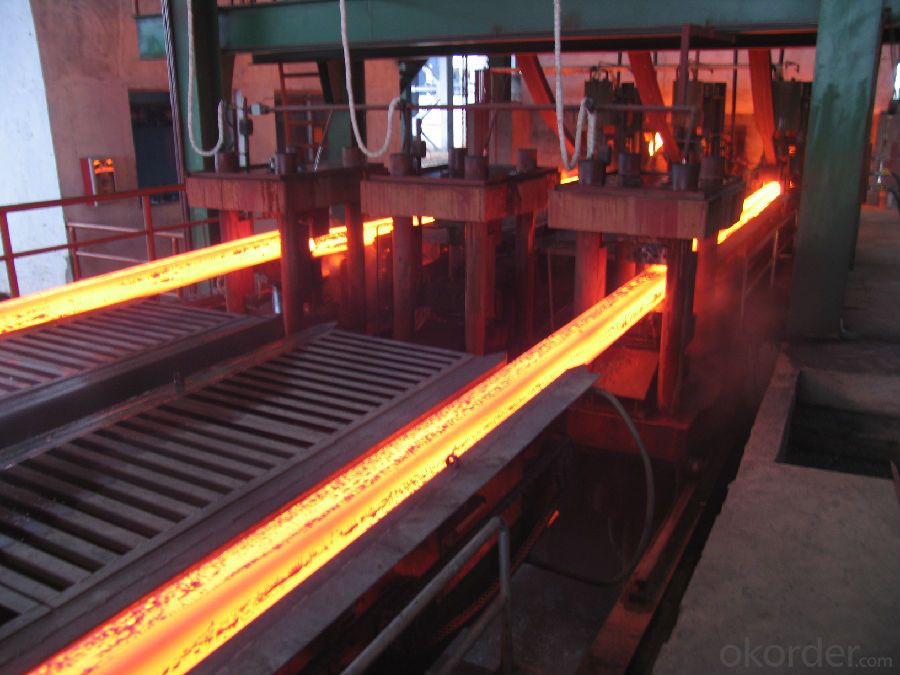
Specifications of Q235/3SP 155MM Blast Furnace Hot Rolled Steel Billet
Quality | Q/BQB 440-2003 | JIS G3312-1994 JIS G3321 | EN 10326-2004 | ASTM A653-02a |
EN 10327-2004 | (BASE PLATE) | |||
(BASE PLATE) | ||||
Commercial Steel | DC51D | SGCC SGLCC | DX51D+Z DX51D+AZ | CS Type A/B/C |
Forming Steel | St01,St02,St03 | SGCD1 SGLCD1 | FS Type A, Type B | |
Drawing | DC52D /DC53D | - | DX52D+Z DX52D+AZ | DDS TYPE A/C |
Steel | DX53D+Z DX53D+AZ | |||
Structural | S280GD (StE28) | SGC400 SGLC400 | S280D+Z DX54D+AZ | SS275 |
Steel | S350GD (StE34) | SGC440 SGLC440 | S350D+Z S350D+AZ | SS340 Class1 |
FAQ of Q235/3SP 155MM Blast Furnace Hot Rolled Steel Billet
We have organized several common questions for our clients,may help you sincerely:
1. How Can I Visit There?
Our company is located in Tianjin City, China, near Beijing. You can fly to Tianjin Airport Directly. All our clients, from home or aboard, are warmly welcome to visit us!
2. How Can I Get Some Sample?
We are honored to offer you sample.
3. Why choose CNBM?
Our delivery time about 15-20days for standard sizes, if you have other requirements like hardness, quanity and width ,it is about 20-40days. But don't worry we also try our best for the delivery time ,because time longer and our cost is higher.
- Q:How are steel billets labeled for identification purposes?
- Steel billets are typically labeled for identification purposes through various methods such as stamping or tagging, where important information such as size, grade, heat number, and production date are marked directly on the billet or attached to it. This labeling allows for easy traceability and identification throughout the manufacturing and supply chain processes.
- Q:What are the different types of steel billets used in the manufacturing industry?
- There are several different types of steel billets used in the manufacturing industry, each with its own unique properties and qualities. Some of the most common types include: 1. Carbon Steel Billets: These are the most widely used type of steel billets and are made primarily from iron and carbon. They are known for their high strength and durability and are used in a variety of applications, including construction, automotive, and machinery manufacturing. 2. Alloy Steel Billets: Alloy steel billets are made by adding various alloying elements to carbon steel, such as manganese, nickel, chromium, and molybdenum. This results in improved properties such as increased strength, hardness, and resistance to corrosion. They are often used in the production of high-strength components and machinery parts. 3. Stainless Steel Billets: Stainless steel billets are made from iron, chromium, and other alloying elements, such as nickel and molybdenum. They are highly resistant to corrosion and staining and are commonly used in the manufacturing of kitchen appliances, automotive parts, and medical equipment. 4. Tool Steel Billets: Tool steel billets are specifically designed for use in the production of tools, dies, and molds. They have high hardness, wear resistance, and toughness, making them ideal for applications that require cutting, shaping, or molding materials. 5. Micro-Alloyed Steel Billets: These billets contain small amounts of alloying elements, such as vanadium, niobium, or titanium. They are used to improve the strength and toughness of the steel, making them suitable for structural applications in industries such as construction and transportation. It's important to note that these are just a few examples of the different types of steel billets used in the manufacturing industry. There are many other specialized types available, each tailored to meet specific requirements for different applications and industries.
- Q:What are the main factors affecting the electrical conductivity of steel billets?
- The electrical conductivity of steel billets is primarily influenced by several key factors. 1. Composition: The chemical composition of steel, particularly the presence of alloying elements, significantly affects its electrical conductivity. Elements such as carbon, manganese, silicon, and phosphorus can alter the conductivity properties of steel. 2. Impurities: The presence of impurities in steel, such as sulfur and oxygen, can lower its electrical conductivity. These impurities can create barriers to the flow of electric current within the material. 3. Grain structure: The grain structure of steel, which is influenced by factors like temperature and cooling rate during the manufacturing process, can impact its electrical conductivity. A fine-grained structure generally results in higher conductivity due to the presence of fewer barriers to electron flow. 4. Heat treatment: The heat treatment process applied to steel billets can affect their electrical conductivity. Specific heat treatments, such as annealing or quenching, can modify the microstructure of the material and consequently impact its conductivity. 5. Temperature: Temperature has a significant effect on the electrical conductivity of steel billets. Generally, as temperature increases, the conductivity decreases due to increased thermal vibrations that impede the flow of electrons. 6. Surface conditions: The surface condition of steel billets, including the presence of oxides, scale, or contaminants, can influence their electrical conductivity. A clean and smooth surface promotes better conductivity by reducing any barriers to electron flow. 7. Mechanical stress: The presence of mechanical stress or strain in steel billets can affect their electrical conductivity. Deformation caused by processes such as rolling, forging, or bending can alter the material's crystal structure and introduce dislocations, which can impact conductivity. Overall, the electrical conductivity of steel billets is a complex property that is influenced by various factors such as composition, impurities, grain structure, heat treatment, temperature, surface conditions, and mechanical stress. Understanding and controlling these factors is crucial for ensuring the desired electrical conductivity in steel billets for various applications.
- Q:What are the main types of defects found in steel billets?
- The main types of defects found in steel billets are surface defects, internal defects, and segregations. Surface defects refer to any irregularities, cracks, or discontinuities present on the outer surface of the steel billet. These defects can include scale, scratches, pits, and surface cracks. Surface defects can be caused by improper handling during transportation or storage, improper handling during the manufacturing process, or inadequate surface cleaning. Internal defects are flaws or imperfections that occur within the inner structure of the steel billet. These defects can include inclusions, cavities, blowholes, porosity, and non-metallic inclusions. Internal defects can be caused by improper melting and casting processes, improper cooling and solidification, or the presence of impurities in the steel. Segregations refer to the non-uniform distribution of elements or impurities within the steel billet. This can result in areas of the billet having different chemical compositions or mechanical properties. Segregations can be caused by inadequate mixing during the melting process, improper pouring and solidification, or the presence of impurities in the raw materials. Detecting and removing these defects is crucial to ensure the quality and integrity of steel billets. Various non-destructive testing techniques such as visual inspection, ultrasonic testing, magnetic particle testing, and eddy current testing are used to identify and characterize these defects. Once detected, appropriate measures such as grinding, machining, or heat treatment can be employed to remove or mitigate the defects.
- Q:What are the different methods used for heating steel billets?
- Heating steel billets can be achieved through various methods, each tailored to meet specific application requirements and constraints. Some commonly employed techniques include: 1. Induction Heating: By passing an alternating current through a coil, electromagnetic induction generates a magnetic field that induces electrical currents in the billet, subsequently producing heat. This method provides precise and controllable heating, ensuring uniformity throughout the billet. 2. Gas Furnaces: Utilizing burners, gas furnaces generate heat that is then transferred to the steel billets via convection. Commonly fueled by natural gas or propane, these furnaces offer flexibility in terms of temperature control, heating rate, and energy efficiency. 3. Electric Resistance Heating: This method involves passing electric current through resistive elements, such as heating elements or heating pads, in direct contact with the steel billets. The resistance to the electric current generates heat, which is then transferred to the billets. Electric resistance heating is typically used for smaller-scale operations or applications with specific heating requirements. 4. Flame Heating: Flame heating employs an open flame, usually produced by a gas burner, to heat the steel billets. The billets absorb the radiant heat emitted by the flame, resulting in heating. Flame heating is commonly utilized for larger billets or applications that necessitate rapid heating. 5. High-Frequency Heating: Through the use of electromagnetic fields, high-frequency heating achieves billet heating. The billets are positioned within a coil, and a high-frequency alternating current is passed through the coil, generating electrical currents in the billets. Heat is produced as a result of the resistance to these electrical currents, ensuring rapid and uniform heating. 6. Laser Heating: High-powered lasers are employed in laser heating to heat the steel billets. The laser beam is focused on the billet's surface, allowing for intense heat generation through the absorption of laser energy. Laser heating provides precise and localized heating, making it suitable for specific applications or for heat treating small areas of the billets. These aforementioned methods represent only a fraction of the techniques commonly employed for heating steel billets. The choice of method depends on various factors, including the required heating rate, temperature control, energy efficiency, and the specific characteristics of the billets.
- Q:What are the different methods of steel billet surface etching?
- There are several different methods of steel billet surface etching that are commonly used in various industries. These methods include chemical etching, electrolytic etching, and laser etching. 1. Chemical etching: This method involves immersing the steel billet in a chemical solution, usually an acid, that selectively removes a thin layer of material from the surface. The choice of the chemical solution depends on the specific requirements of the etching process, such as the desired depth and pattern. Commonly used chemicals for steel etching include hydrochloric acid, nitric acid, and ferric chloride. 2. Electrolytic etching: In this method, an electric current is passed through the steel billet while it is immersed in an electrolyte solution. The current causes a controlled dissolution of the surface metal, resulting in a desired etched pattern. Electrolytic etching offers precise control over the etching process and can produce intricate and detailed designs. It is often used for marking or labeling steel billets with logos, serial numbers, or other identification marks. 3. Laser etching: Laser etching is a non-contact and highly precise method of surface etching. It involves using a laser beam to selectively remove material from the steel billet surface. The laser beam is directed and controlled by computer software, allowing for intricate and customizable designs. Laser etching can be used to create permanent markings, logos, or patterns on steel billets. It is widely used in industries such as automotive, aerospace, and electronics. Each of these methods has its advantages and limitations, and the choice of the etching method depends on factors such as the desired design, the material properties of the steel billet, and the production requirements.
- Q:How are steel billets used in the production of construction components?
- Steel billets are an essential raw material in the production of construction components. They are primarily used in the manufacturing of various structural elements such as beams, columns, and bars that form the framework of buildings and infrastructure projects. The process begins with steel billets, which are semi-finished products made from molten steel that has been cast into rectangular or square shapes. These billets are then further processed and transformed into specific construction components through various manufacturing techniques. One common application of steel billets is in the production of beams, which are essential for supporting the weight of floors, roofs, and walls in buildings. Billets are processed through rolling mills, where they are heated and passed through a series of rollers to shape them into the desired beam profile. This process allows for the production of beams of different sizes and lengths, catering to the unique requirements of each construction project. Steel billets are also used in the production of columns, which provide vertical support to structures. Similarly to beams, billets are processed through rolling mills to obtain the required column shape. The columns are then joined to the beams to form the skeletal framework of the building, providing strength and stability. In addition to beams and columns, steel billets are employed in the production of bars used for reinforcing concrete. These reinforcing bars, commonly known as rebar, are crucial for enhancing the strength and durability of concrete structures. Billets are again processed through rolling mills to create rebar of various diameters and lengths. The rebar is then embedded within the concrete to provide tensile strength, preventing cracking and increasing the overall structural integrity. Overall, steel billets play a vital role in the production of construction components by serving as the starting point for the manufacturing process. They are transformed into beams, columns, and rebar, providing the necessary strength and stability required in the construction of buildings and infrastructure projects.
- Q:What are the common shipping methods for steel billets?
- The common shipping methods for steel billets include container shipping, bulk shipping, and rail transportation. Container shipping is a popular method for transporting smaller quantities of steel billets. The billets are loaded into standard shipping containers, typically 20 or 40 feet in length, and then shipped via cargo vessels. This method allows for easy handling and ensures the protection of the billets during transit. Bulk shipping is commonly used for larger quantities of steel billets. In this method, the billets are loaded directly onto the cargo vessel without the need for containers. This allows for cost-effective transportation of large volumes of billets. Bulk carriers are specially designed to handle heavy cargo and ensure secure delivery. Rail transportation is another common shipping method for steel billets, especially for domestic or regional transportation. The billets are loaded onto specialized railcars, capable of carrying heavy loads, and transported via rail networks. This method offers efficient and reliable transportation, particularly for shorter distances. Ultimately, the choice of shipping method for steel billets depends on factors such as quantity, destination, cost, and logistical capabilities. Each method has its own advantages and considerations, and it is crucial to select the most suitable option based on the specific requirements of the shipment.
- Q:What are the potential applications of steel billets in the medical aftermarket?
- The medical aftermarket offers a wide range of potential applications for steel billets. One important application is the manufacture of surgical instruments, such as scalpels, forceps, scissors, and orthopedic implants. Steel billets are capable of producing high-quality and durable surgical instruments due to the strength and corrosion resistance of steel. Furthermore, steel billets are also useful in the production of medical equipment and devices. For instance, they can be used to create components for X-ray machines, CT scanners, and MRI machines. The excellent conductivity and high strength-to-weight ratio of steel make it a suitable choice for these demanding applications. In addition, steel billets can be utilized in the manufacturing of medical furniture and fixtures. Steel is commonly employed in the construction of hospital beds, examination tables, and cabinets due to its durability and ease of maintenance. Steel billets can provide the necessary raw material for the production of these essential medical items. Moreover, steel billets can also be employed in the fabrication of prosthetics and orthotics. These devices often require materials that are both strong and lightweight to ensure proper functionality and comfort for patients. Steel billets can be processed into various shapes and sizes to create prosthetic limbs, braces, and other orthopedic devices. In summary, the diverse and crucial potential applications of steel billets in the medical aftermarket cannot be underestimated. From surgical instruments to medical equipment, furniture, and prosthetics, steel billets possess the necessary qualities of strength, durability, and corrosion resistance to meet the demanding requirements of the medical industry.
- Q:What are the cost implications of using steel billets in manufacturing?
- Using steel billets in manufacturing can have several cost implications. First and foremost, the cost of steel billets themselves needs to be considered. The price of steel billets can vary depending on factors such as market demand, availability, and the grade of steel used. Therefore, fluctuations in steel prices can directly impact the cost of manufacturing. Additionally, the cost of transportation and logistics needs to be taken into account. Steel billets are heavy and bulky, requiring specialized handling and transportation methods. This can result in higher shipping costs, especially if the manufacturing facility is located far away from the source of steel billets. Furthermore, the cost of processing and shaping steel billets into the desired form for manufacturing needs to be considered. This includes expenses associated with cutting, welding, forging, and any other necessary fabrication processes. The complexity of these processes and the required machinery can have a significant impact on the overall cost of using steel billets. Another cost implication is related to the quality of steel billets. Inferior quality billets can lead to lower product quality and higher rejection rates, resulting in increased manufacturing costs. Therefore, it is important to source steel billets from reputable suppliers to ensure consistent quality and minimize the risk of defects. In terms of long-term costs, the durability and strength of steel make it an attractive choice for manufacturing. Steel is known for its longevity and resistance to wear and tear, reducing the need for frequent replacements and repairs. This can result in long-term cost savings for manufacturers. Lastly, it is essential to consider the environmental and sustainability aspects associated with using steel billets. Steel production is energy-intensive and can have a significant carbon footprint. Increasingly, manufacturers are being held accountable for their environmental impact, which can lead to additional costs in terms of compliance with regulations or implementing sustainable practices. In summary, the cost implications of using steel billets in manufacturing involve the price of the billets themselves, transportation costs, processing expenses, quality considerations, long-term durability, and sustainability factors. Careful analysis of these cost factors is crucial for manufacturers to make informed decisions and optimize their manufacturing processes.
1. Manufacturer Overview |
|
|---|---|
| Location | |
| Year Established | |
| Annual Output Value | |
| Main Markets | |
| Company Certifications | |
2. Manufacturer Certificates |
|
|---|---|
| a) Certification Name | |
| Range | |
| Reference | |
| Validity Period | |
3. Manufacturer Capability |
|
|---|---|
| a)Trade Capacity | |
| Nearest Port | |
| Export Percentage | |
| No.of Employees in Trade Department | |
| Language Spoken: | |
| b)Factory Information | |
| Factory Size: | |
| No. of Production Lines | |
| Contract Manufacturing | |
| Product Price Range | |
Send your message to us
Q235/3SP 155MM Blast Furnace Hot Rolled Steel Billet
- Loading Port:
- Tianjin
- Payment Terms:
- TT OR LC
- Min Order Qty:
- 2000 m.t.
- Supply Capability:
- 30000 m.t./month
OKorder Service Pledge
OKorder Financial Service
Similar products
New products
Hot products
Related keywords
